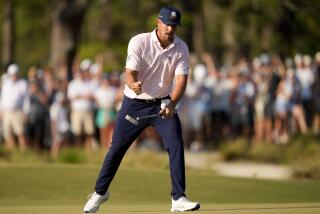PAYNE STEWART 1957-1999
It was the clothes. Payne Stewart’s story was about the clothes. He was what he wore. He wasn’t an athlete, he was a mannequin.
That’s what I always thought. That’s what a lot of people thought. He wasn’t the guy with the swing, he was the guy in the knickers.
Until I walked with him through the North Carolina woods one rainy Sunday afternoon in June.
When the walk started, I couldn’t stop looking at the white knee socks and jaunty blue cap.
When the walk ended an hour later, I couldn’t see anything other than the man.
The place was Pinehurst Country Club.
The setting was the final four holes on course No. 2.
The destination was the U.S. Open championship.
It was Stewart and Phil Mickelson in a wet, windy duel that looked like De La Hoya-Trinidad, and felt like Packers-Bears.
It was Stewart falling behind, then taking the lead, then sinking a 15-foot putt through the pelting rain to win one of the most dramatic Opens in history.
It was the reason Monday’s tragedy elicited not only the question of why, but why now?
For many, Payne Stewart died only months after he finally came to life.
His heart stopped just after the sports world saw how big it was.
He crashed mere moments after soaring.
We heard the news Monday, a terrible goodbye to a man we were just getting to know, and our breath was also taken.
I first remember the 15th hole. I was kneeling on the side of the green as Stewart rolled an eight-foot par putt long.
With the miss, Mickelson took the lead. Stewart shook his head, and we knew what would happen next.
He had choked the U.S. Open the previous season, blowing a four-shot lead on the final day. He was doing the same thing now. He was done.
“Mud all over his white socks,” I wrote in my notebook.
Then Payne Stewart threw the mud back in my face, in all of our faces. He marched up to the 16th green, sank a downhill 25-footer for par, Mickelson missed, and they were tied again.
It was then that I noticed, in this duel for the ages, not once would Stewart look at this person he was dueling.
Mickelson would swing, and Stewart would be fiddling with his clubs. Mickelson would putt, and Stewart would be picking something out of his shoes.
In this game of high-stakes poker, Stewart was playing solitaire.
In these distant stares into space and at the ground, Stewart wasn’t merely showing us, he was teaching us.
No matter how much it seems that life pits you against the other guy, it’s never about the other guy.
It’s always just about you.
“I was only thinking about getting the job done,” Stewart said at the time.
Chomping fiercely on his gum, Stewart placed his 17th tee shot within three feet of the hole. Mickelson landed eight feet away.
Stewart made his putt. Mickelson missed his putt. Stewart led by one, with one hole left, but one more mountain to climb.
Mickelson’s second shot landed on the 18th green. Stewart’s second shot landed about 77 yards away.
The crowd was roaring, the rain was blowing. Stewart’s pretty plus-fours were soggy, his cap pulled low.
“This is not golf,” I wrote in my notebook. “This is fourth and one from the four-yard line.”
And Payne Stewart stepped out of that department store window, put his head down, and ran.
Those who didn’t think he had it in him saw that he had this in him--a great shot to within 15 feet of the hole.
Then a 15-foot putt to win it.
Everyone talks about the putt, the fist pumps, the caddie hugs that have been replayed repeatedly this week.
But I liked the shot before it better, the one through the mist and the rain, the one that could have so easily disappeared into the woods like so many Stewart pressure shots before it.
The championship won, Stewart ran his sweaty palms over his pants, a weary construction worker who had just finishing remodeling his image, maybe his life.
When I learned of his death Monday, I thought back to that scene, and tried to remember the color of those pants.
I couldn’t.
*
Bill Plaschke can be reached at his e-mail address: bill.plaschke@latimes.com.
More to Read
Go beyond the scoreboard
Get the latest on L.A.'s teams in the daily Sports Report newsletter.
You may occasionally receive promotional content from the Los Angeles Times.











